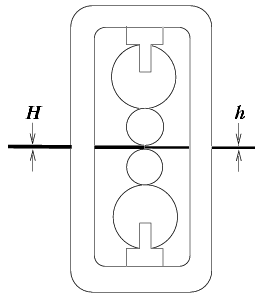
CDS 101/110 Problem set #1, Problem 6. The rolling mill example, hw1rollmill.mdl is a simplified model of a steel rolling mill. The control problem is to control the exit thickness of a sheet of steel that is fed between two rollers.

The exit thickness h of the steel is related to the gap between the rollers, which depends on the unloaded position of backup rollers (also called the screw position), s and the input thickness H. The force on the rollers is reasonably modeled by
F = M ( h - s )
as well as
F = W ( H - h )
where M and W are constants.
Combining these two gives
h ( M + W ) = M s + W H
![]()
Measurement and actuator dynamics are modeled with time delays of 1 second and 0.01 seconds, respectively. A proportional-integral control law is incorporated into the model whose job is to try and regulate the output thickness to the desired thickness.
Right-click hw1rollmill.mdl and save it to a local drive. Open it with MATLAB (Simulink) and follow the instructions given in Problem Set #1.
Notes: